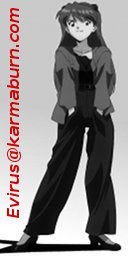|
|
- HOME
- Archive for RECOMMENDATIONS.
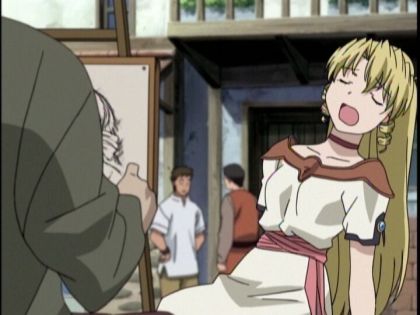
Improper comportment for a princess.
Starting with the episode where the Casulls meet EIROTE! and Senes, there is a lot of exposition as the series transitions from "Pacifica on the run" to the "we told you that story to tell you this one" portion of Scrapped Princess. I advise new viewers to listen carefully because the show rips through a lot of backstory in a relatively short time, but basically explains everything that's going on. There's a running gag within the show about how difficult it is to digest all this sometimes-boring information so quickly, so it's not too bad overall. It's not like shounen jive with people boasting about power levels or crap like that ad infinitum, at least.

There's a good reason for these blank stares.
The big event that turns a lot of viewers off is an amnesia angle that appears in disc four of the DVD set. I usually don't care for amnesia stories but this is honestly resolved pretty quickly. Plus it sets up a great sight gag I've completely missed during my previous watchings. It's quick, but so obvious I don't know how I failed to notice it before. (It occurs at the ramen stand.)

Shannon and CZ share an umbrella.
This is probably my fourth time watching Scrapped Princess, yet somehow I also never noticed before that Shannon and Zefiris combining contains obvious sexual overtones in the second half of the series. It's definitely intentional, although less overt than the VanDread metaphors. My guess is it's intended to highlight Zefiris' jealousy when Shannon and CZ's relationship grows less hostile.
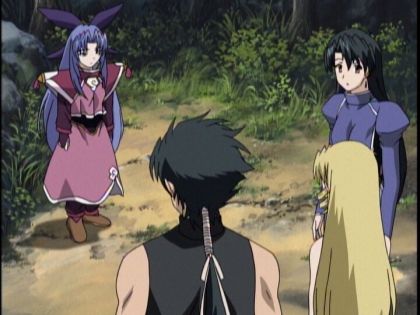
Zefiris might be shorter than Shana and Taiga.
I still maintain Scrapped Princess is an excellent series. Really, I waited too long to buy these DVDs. I'm not sure if the cliffhangers help or hurt the show for viewers marathoning the series for the first time. (If I remember right, only two episodes don't end in cliffhangers.) However, I marathoned Monster the first time I watched it, and that series also has a lot of cliffhangers. With Monster I just kept churning through more episodes. The first time I watched Scrapped Princess, I had to impatiently wait a week—every week. New viewers today probably won't enjoy/endure the same wait. With the aforementioned caveats in place, I'm still going to put Scrapped Princess on my short list of recommendations.
Posted in RECOMMENDATIONS, Scrapped Princess | | Permanent Link
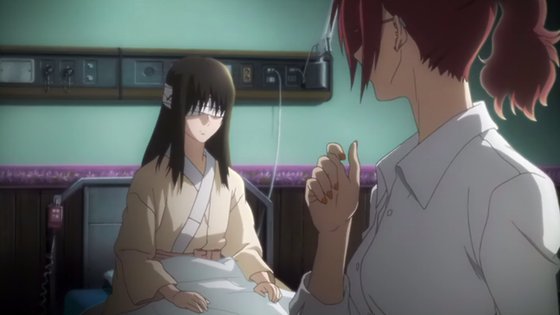
Shiki and Touko.
Just so you know, Kara no Kyoukai IV is fully awesome and I will spoil the shit out of it if you don't go and watch it RIGHT NOW.
[Spoilers: Shiki gets better.]
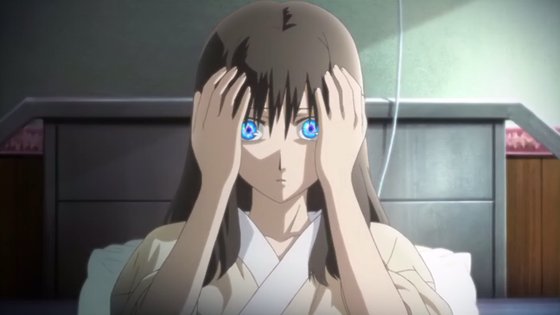
I WARNED YE.
Seriously, though, Kara no Kyoukai is great and you should watch it.
Posted in Kara no Kyoukai, RECOMMENDATIONS | Tags: Kajiura Yuki, TYPE-MOON, ufotable | Permanent Link
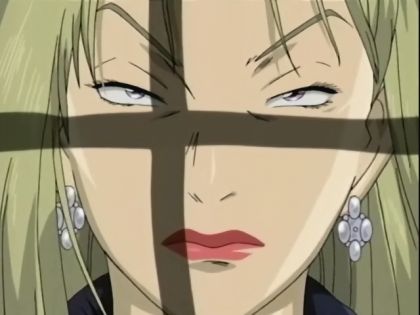
Eva is displeased.
After years of waiting, the first batch of Monster DVDs is now available. No-brainer, right? Unfortunately, it's not so simple. Reportedly, there have been some changes to the musical score in the form of rearranged background music, the addition of music to previously silent scenes, and the elimination of vocals from the ED. Now, it would be easy to simply blame Viz for these changes. After all, I'm still waiting for them to release more Full Moon wo Sagashite. After more than two years, however, I have to assume Viz has abandoned the title entirely in the face of a collapsed anime market.
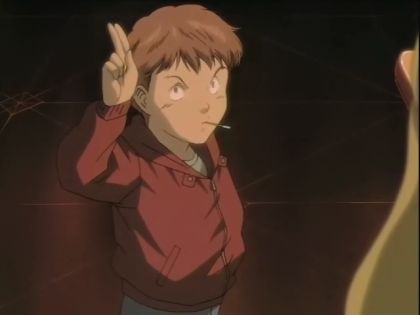
I normally hate kid characters, but Dieter is all right.
I am inclined to pass up DVD releases where someone has monkeyed around with the original material, but from the looks of it, this may not be Viz's fault, or even something they had any control over. If, as the above discussion on the mania.com née animeondvd.com forums suggest, there really are two sets of masters in play—the masters used for the Japanese R2 release, and an interlaced set of masters with changes to the audio used for European and North American DVDs, then it is possible Viz was stuck in a take-it-or-leave it situation and should be commended for offering this exceptional series in a 13-episode batch (of 74 episodes total) during a soft market.
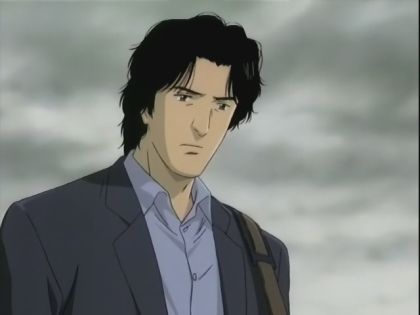
Dr. Tenma is displeased.
I'm probably going to buy this anyway, despite my hostility towards the changes to the original material. This is Monster, after all. Considering I bought ADV's release of Azumanga Daioh (with the inexplicable use of MISS SAKAKI) and Full Metal Panic? Fumoffu (with the inexcusable dot crawl), I almost have to buy this out of general principle. Still, I have to wonder how much of an effort Viz made at securing the original masters used for the Japanese DVD releases. I hope they're not just half-assing it here, because owning all of Monster even at 45% off MSRP is going to run about $200 providing Viz doesn't abandon the series halfway through, like they did with the best series of all time.
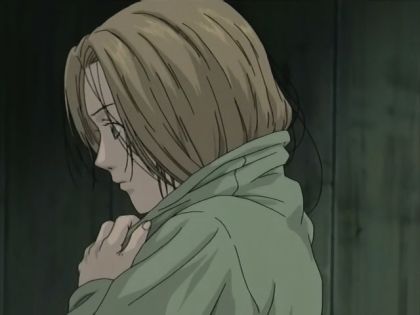
Nina is Noto Mamiko's best role.
Is it all right to call this a Prisoner's Dilemma? Start buying it from the get-go and take the risk the releases will stall, or wait until the entire series is available and thereby increase the chances Viz won't complete it because nobody has been buying the discs. From a casual look around, it appears as if anime sales really are in the toilet. This surprises nobody, I'm sure. I really am still waiting for Blu-ray releases. Really! I will buy the shit out of Blu-ray releases even if the video is merely upscaled from SD masters. At a minimum, it means escaping the horror of that bitmap subtitle format DVDs have inflicted on us for more than a decade now.
Posted in Monster, RECOMMENDATIONS | Tags: DVDs and Blu-ray discs, George Lucas, Mamikore, OP ED, Viz | Permanent Link
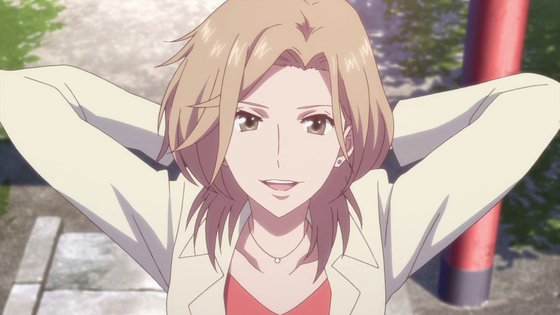
You're still a lousy mom, Satsuki.
The best show I watched spring 2011 was Hanasaku Iroha. Consistently engaging, with characters I cared about and the high levels of animation quality I've come to expect from P.A. Works, I always looked forward to the next episode. I'm glad it's continuing for another cour in summer 2011. However, I initially thought Ohana would take an early lead in the race for Girl of the Year, but surprisingly she is thus far not in the running. In fact, it is scene-stealing Minko who is poised to garner the year-end nomination, provided she gets past Tomoe first, the current front runner for Hanasaku Iroha's Best Girl.
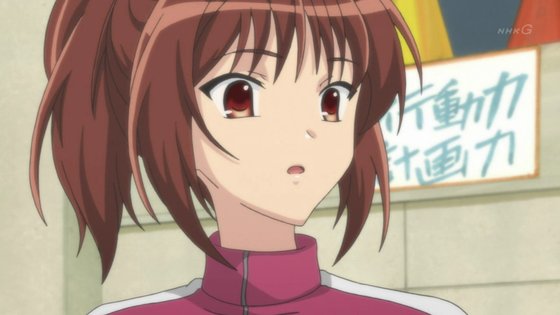
Surprise! Moshidora gets better with each episode!
It almost doesn't feel as if Moshi Kōkō Yakyū no Joshi Manager ga Drakkā no “Management” o Yondara was part of spring 2011 because it ended so early. (Its 10 episodes aired during consecutive weeknights for two weeks at the start of spring 2011.) Accused early on of having low production values and an unengaging storyline, Moshidora's detractors mostly abandoned the series by the second episode. It's too bad, really, because Moshidora improved with nearly every episode, culminating in a satisfying finale that underscores the difference between anime based on juvenile or young adult "light" novels and anime based on books aimed at adults.
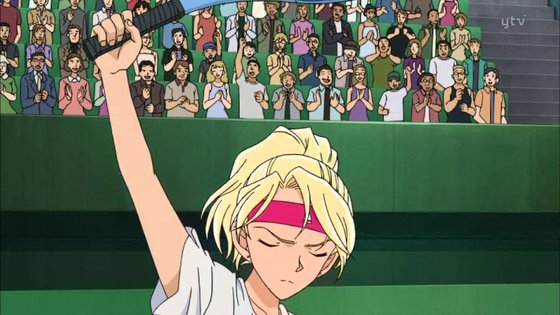
Minerva Glass is here to eat bangers & mash and kick ass.
And she's all out of bangers & mash.
Detective Conan is as good as it ever was. In fact, it was better than usual this season. The long London arc in particular was a nice change of scenery. Minerva Glass was also a nice addition to the cast, although I suspect she will not be a recurring character. Many of her scenes reminded me of the old David Foster Wallace article "The String Theory." Be sure to read all the footnotes.
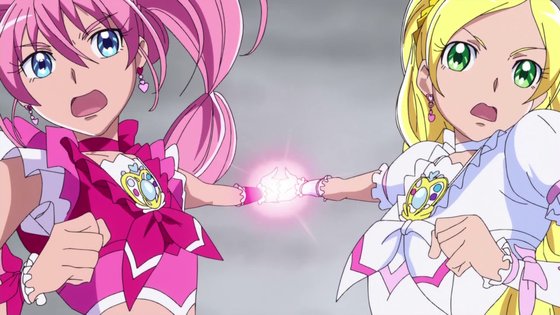
Suite Pretty Cure is here to eat cake and kick ass.
And they're all out of...wait, there's some more cake in the house.
Suite Precure♪ suffered from weak-protagonist syndrome, but Hibiki and Kanade have mostly found their footing by now. I'm glad the show is drawing out its Cure Muse mystery, throwing out a number of red herrings regarding her identity and her role. This makes Toei only marginally better at protecting its properties from spoilers, though. Cure Beat's identity and details were widely known months in advance.
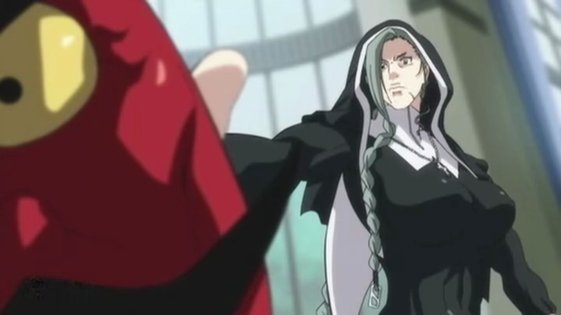
Big Mom is big.
The second season of Seikon no Qwaser is not as good as the first. The difficulty comes in trying to live up to the predecessor's reputation or trying to surpass the first season's achievements. Along those lines, it was really only successful with episode 10. Probably developing its characters more would have served Qwaser II better.
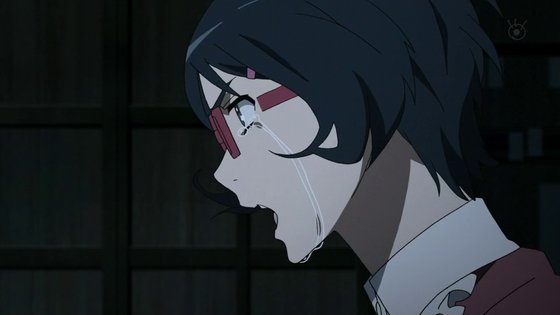
Ahh! Ghost glasses!
I did not enjoy Ano Hi Mita Hana no Namae o Boku-tachi wa Mada Shiranai nearly as much as most people seemed to have. Ano Hana had a huge following of emotionally invested fans. I found every character irritating, trite, juvenile, and overly melodramatic. It didn't help that Cross Game recently dealt with a similar theme in a far superior manner. (Haruka Tomatosauce, Anaru from Ano Hana, plays Aoba in Cross Game. You should give Cross Game a try if you haven't seen it already.) It also kinda bugged me how everyone's thick emo glasses developed side-view transparency so that they wouldn't obscure the characters' eyes in profile, but now I'm nitpicking.
I dropped X-Men even though I thought it was pretty good. I'm just waiting for the English dub, since the show seemed so western. I heard there's stunt casting for the English voices, though. Something about the cast of Heroes. I'm not really sure.
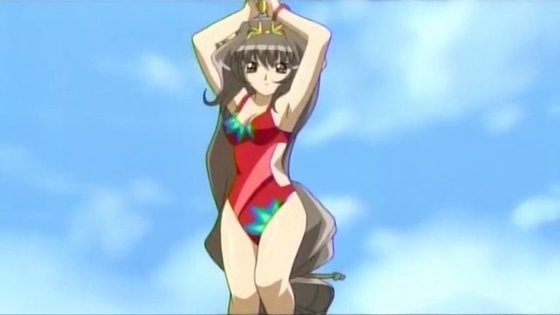
Cosprayers Line.
I sort of wanted to watch three episodes of Pretty Rhythm Aurora Dream to see what in Hell King in Prussia was talking about about, but the show is too awful. I could suffer through more if it had some redeeming qualities, but man, watching that crap is painful. Yes, Pretty Rhythm Aurora Dream is worse than Cosprayers. At least there weren't any live-action segments in the second episode.
Posted in Ano Hi Mita Hana no Namae o Bokutachi wa Mada Shiranai, BEST GIRL, Detective Conan, Hanasaku Iroha, Moshidora, Pretty Rhythm Aurora Dream, RECOMMENDATIONS, Season Summary, Seikon no Qwaser, Suite Precure♪, WORSE THAN COSPRAYERS, X-Men | Tags: baseball, Dropped Shows, Fan Service, footnotes, Legs that go up to her neck, Mahou Shoujo, Season Conclusion, Spring 2011 | Permanent Link
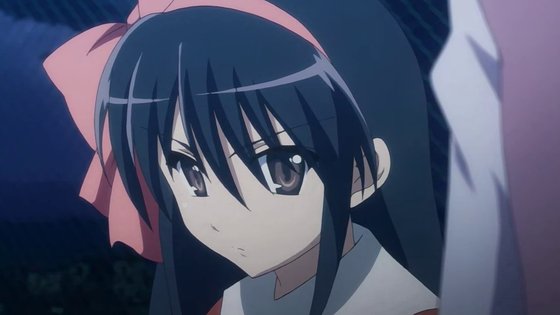
Shana scenes suck when her hair isn't on fire.
I generally strongly discourage people from skipping seasons. Typically they do it so they can follow something shiny and new and/or watch something at the same time as their friends so they'll have something to talk about. This can lead to very poor decisions, such as watching Diebuster before watching Gunbuster, or watching Shikabane Hime: Kuro without watching Shikabane Hime: Aka. I have less of an issue with people skipping previous Mobile Suit Gundam seasons (at least for series in different continuities) since there are so damn many of them, or skipping previous Macross iterations, although I do insist on people watching the original Cho Jiku Yosai Macross; do not be tempted to lean on Do You Remember Love? instead. Good movie, but really not a substitute for the original series—not at all.
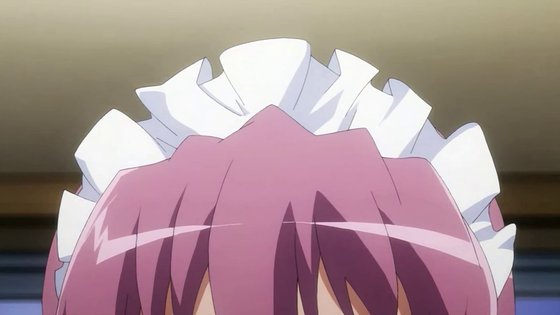
Carmel's head thingy had the best lines.
But while I feel it is wrong on principle to skip seasons, especially when one's reasons for doing so fall in the "shiny and new" camp, I can make an exception for Shakugan no Shana II. I watched 24 episodes of this second Shana season because I enjoyed the first season and wanted to give the upcoming third season a try. This may have been a mistake. Shana II is every bit as awful as its reputation warned me. Shana II is 24 episodes of tedium occasionally interrupted by insipid fights. It is WORSE THAN COSPRAYERS, I finished Shana II with great reluctance. It was never ever actually BAD in the way Limeiro CROSS or Macademi Wasshoi! were truly bad; it just wasn't ever compelling, or even interesting.
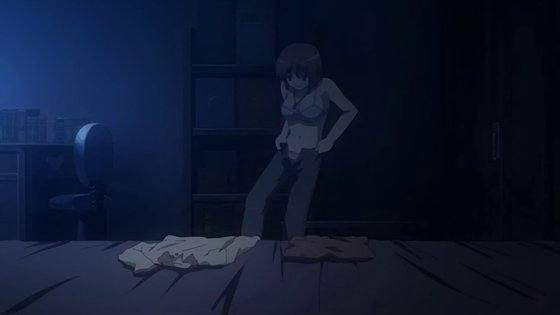
Kazumi has a little trouble with her jeans.
To put things into perspective, the multi-episode climactic battle at the end of Shana II kept giving me flashbacks to the Demonbane anime. Now, Demonbane is by no means good, but I have to say that it was at least more interesting than Shana II. This is especially true of the fights. I've long harped on J.C. Staff and its poor track record when it comes to animating fight scenes (excellent Azumanga Daioh snowball fight notwithstanding), but I remember even the worst Demonbane fights against the shrieking mad scientist to be more engaging than climactic season finale fight scene against the shrieking mad scientist of Shana II. And I'm not just saying that because Mr. Eroge Protagonist from the Demonbane anime had to soul kiss a book every time to make his giant robot go. Well, he didn't have to, probably. He just did. But I digress. Shakugan no Shana II is a horror, and I will be amazed if Shana III requires any foreknowledge of its preceeding season's events. Yeah, I'll still at least start Shakugan no Shana III. It's too late to turn back now. Who knows, maybe the odd-numbered seasons will be good.
Posted in Cho Jiku Yosai Macross, Demonbane, Do You Remember Love?, RECOMMENDATIONS, Shakugan no Shana, Shikabane Hime: Aka, Shikabane Hime: Kuro, Top wo Nerae, WORSE THAN COSPRAYERS | Tags: Autumn 2011, AYAKO DOCTRINE, Built for Sin, Giant Robots, Harem Comedy, Kugimiya Rie, Movies and OVAs, Sequels, Shounen Jive, tsundere | Permanent Link
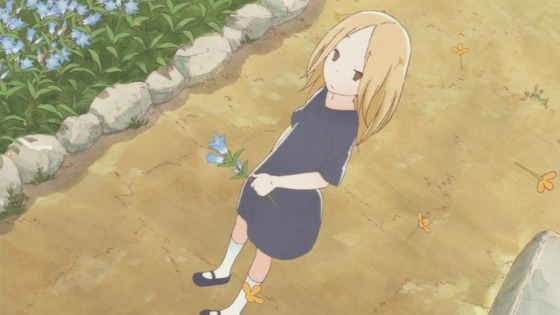
Daikichi's first impression of Rin is a recurring image.
Usagi Drop was one of the best shows from summer 2011, losing the top spot in my rankings only because of its brief 11-episode length. However, based on the outcry the original manga created, the anime's short run was its saving grace, due to the unspeakable horror of the manga's conclusion. Or so it goes.
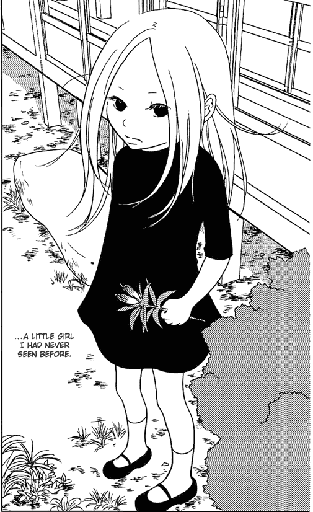
Daikichi sees Rin for the first time, manga version.
I've long learned of the otaku penchant for gross overreaction, so I took the time to read the entire manga myself—something I suspected many of its critics neglected to do. Based on my findings, I can understand why so many otaku reacted the way they did, but I personally had no issues with the manga's ending myself, possibly because I'm much less critical of anime and manga in general; I at least try not to group things into only two categories—AWESOME and HORRIBLE—there is a lot of stuff in that middle ground I enjoy, even if I don't necessarily enjoy all of it.

Here, the Usagi Drop anime ends.
The 11 Usagi Drop anime episodes duplicate the first 25 chapters of the 56-chapter manga almost scene for scene. The anime is very faithful to the source material. The anime also ends where it does because of the manga's timeskip. That's right, more than half of the Usagi Drop story occurs after the timeskip, so arguably the latter half is the "real" story which the first part merely sets up. At a minimum, a truculent reader should at least grudgingly acknowledge the second half is intended to be as important as the first half.
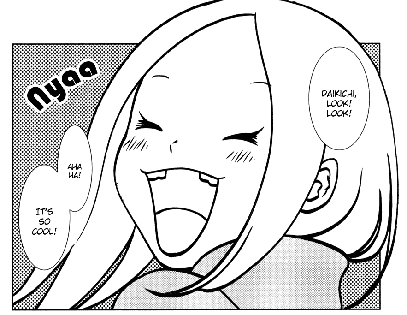
Here, the Usagi Drop manga is merely beginning.
Spoiler Warning: I won't explicitly discuss the manga events, but most readers will probably be able to easily guess the spoilers from context with little effort. When I first heard about the post-timeskip outrage, I compiled a mental list of likely spoilers based on what I knew about otaku and what I knew about Japan and what I had seen in other anime and manga. Sure enough, this list of possible rage-inducing outcomes included two of the spoilers that actually occurred in the manga, although to be fair, I was incorrect about a material detail about one of them and the one I was 100% correct on was the one I had already intuited from a scene in the anime before I had even heard about the entire controversy.
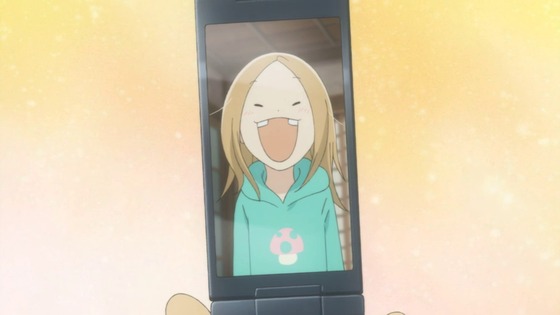
Rin shows off her missing teeth.
So why so much hostility towards the manga's ending? Frankly, I attribute it to one (or both) of two reasons. One, otaku might not be exposed to much western literature and theater if they spend most of their free time voraciously consuming manga and anime. Thus, their expectations as to what is appropriate or acceptable follow different conventions. Two, these conventions themselves are tailored in self-perpetuating otaku-friendly ways to be non-threatening. Yeah, most people angered by the Kannagi ex-boyfriend revelation were joking, but notice how none of the K-On! girls are permitted boyfriends either; even a supporting character requires plausible deniability—even in jest—when she is shown with a possible beau. This is not to say that strangers to manga and anime would not revile the Usagi Drop manga ending, but it's possible those with greater exposure to a variety of "acceptable" endings may give the title more latitude because they are more liberal with their expectations. Expectations are probably key here. For example, because its audience has different expectations, nobody bats an eye when Oedipus has sex with his mother and later puts out his eyes, and nobody cares when a Shakespeare tragedy concludes with a half-dozen dead bodies on the stage. And how many readers of the popular A Song of Ice and Fire fantasy novels are offended by all the rape, incest, and teenage brides?

Tiny pictures are the way of love.
I do not claim it is improper for manga and anime fans to hold different expectations for these works, but I do feel that those embracing narrower allowances contribute to the apparently collective overreaction to the Usagi Drop ending. And I do think they overreacted, especially the ones who were offended by second- or third-hand reports about how it played out instead of investigating the matter themselves. I can understand not wanting to "stain" a cherished impression created by the first half of the story, but someone forcing himself to look away to avoid something he's predetermined to condemn as distasteful strikes me as amusingly immature.
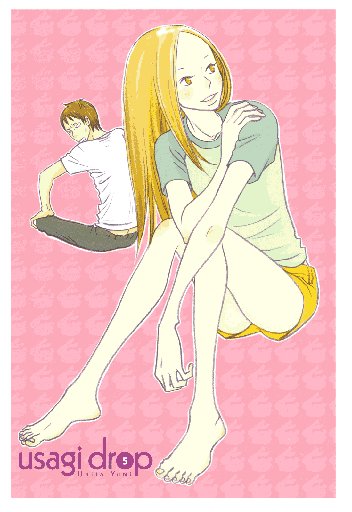
I forgot to mention timeskip Rin has legs that go up to her neck.
Yes, it turns out most of Usagi Drop is a teen drama, but it's not a bad teen drama unless you claim all teen dramas are bad as a matter of general principle. Guess what? After the timeskip, Rin is a teenage girl. And, like I said, since there are more chapters with Rin as a teenager than there are of Rin as a small child, Usagi Drop arguably is a teen drama. And it's not one of those teen dramas where nothing happens. There's kissing! There's sex! There's pregnancy! But there is also devotion and unrequited love.
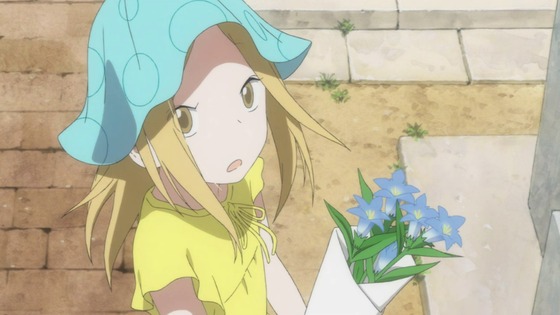
Rin pays her respects.
Frankly, none of this would even be possible were it not for two key elements established in the first half. First, Rin explicitly rejects Daikichi as a father when he broaches the subject. Second, six-year-old Rin is the sweetest, nicest, most well-mannered little girl in history, so Daikichi's parenting—as far as we are shown—consists almost entirely of having a job and being able to sign contracts. Instruction and discipline? Not so much.
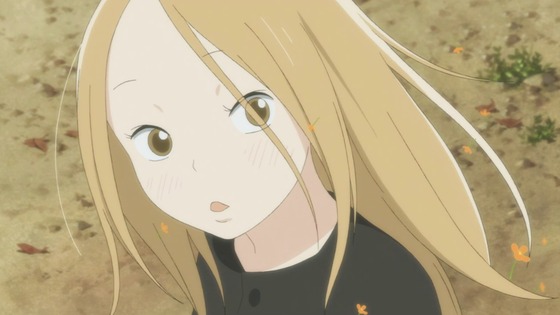
Daikichi remembers how he met Rin.
We also don't see much parenting with regard to Kouki. We know he needed more of it, since he was apparently quite a hellion, but Usagi Drop omits a lot of details. There are at least three really big incidents that occurred between the two arcs, but aside from oblique references to them, the reader remains entirely ignorant as to, you know, what happened.
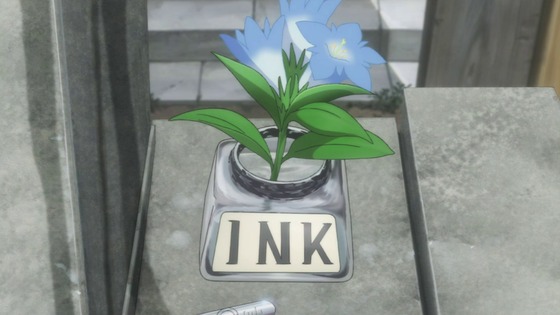
Rin's mother pays her respects.
I've probably said too much already, and if you can't figure out what the big deal is by now, you probably either don't know anything about Usagi Drop to begin with, or you weren't paying attention. If you have figured it out and still refuse to read the manga yourself because you're afraid of tarnishing the image formed by the anime, at least consider this: The first half of Usagi Drop is told from Daikichi's point of view. The second half is from Rin's and Kouki's points of view. This change is what makes the ending work for me.
Posted in Manga, RECOMMENDATIONS, Usagi Drop | Tags: 16-year-old love interests, Childhood Friend, Legs that go up to her neck, Manga, Shoujo, Summer 2011, Tiny Pictures Are the Way of Love, Unrequited Love | Permanent Link
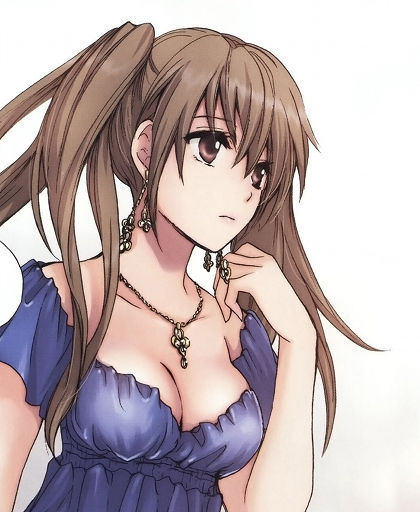
Kano's first appearance.
Despite blogging about anime for more than 10 years, I've only rarely discussed manga, and I don't recall ever recommending any titles—perhaps Nausicaä and Love Hina in the very early days of this blog, back when it was still hosted on Geocities. I've quietly lamented that there are far fewer manga blogs than anime blogs, but never made the effort to redress that shortage myself. Then again, when the anime blogs I follow offer manga recommendations, I've usually disagreed with the bloggers' assessments and lost interest after a few chapters.
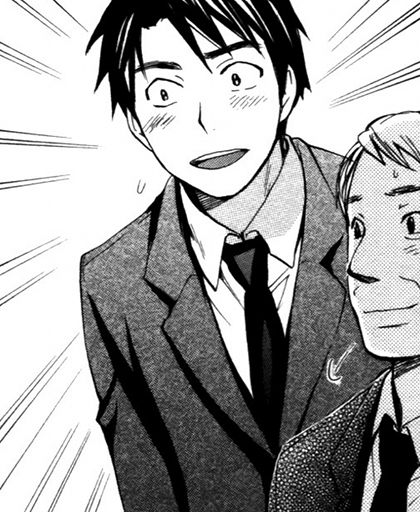
Nitta's job is going well.
Despite the risk of inspiring similar lackluster responses, I'd like to recommend Velvet Kiss by Harumi Chihiro as a currently ongoing adult title that has far exceeded my expectations. I say "adult title" because although genitals are never shown (or censored out), there is regular nudity and sex appears in literally every single chapter.

Kano is a lot nicer when she's asleep.
On its face, Velvet Kiss is a wish-fulfillment manga about a young salaryman who is blackmailed into being a petty rich girl's "friend" (read: gopher and sex slave). It works, though, because Nitta is a reasonably successful and self-assured adult who had an active sex life prior to becoming Kanoko's whipping boy. That is, he's not another school-aged Potato-kun who somehow stumbled into the sweet shit. In fact, Nitta quite openly despises servicing Kanoko. There's a lot angry sex in Velvet Kiss. If forced to describe Velvet Kiss in simple clichés, I would say it's a tsundere sex drama with the lead male taking the rare role as the tsundere.
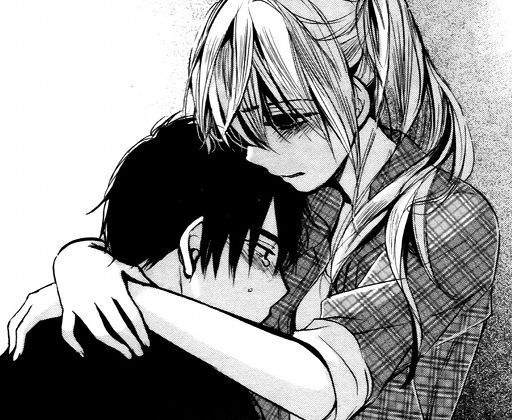
Try a little tenderness.
Simple clichés don't quite do Velvet Kiss justice, as its real triumph is its ability to get the reader to care about the characters. It's a triumph because none of the characters are particularly sympathetic. There is a lot of selfish behavior, treachery, manipulation, and disloyalty in Velvet Kiss, which would normally incite hostility from its readers (excepting those with soft spots for poor little rich girls), but I care enough about Kano and Nitta that I eagerly anticipate each new chapter.
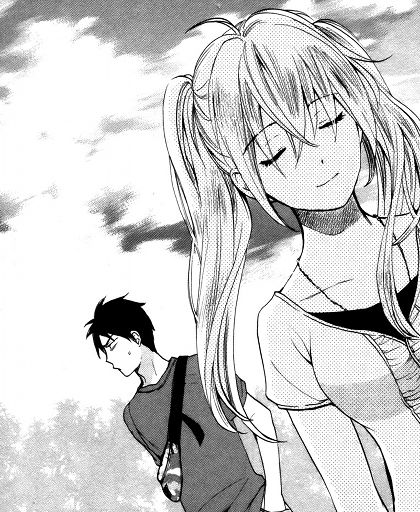
Today was a good day.
As of this post, Soba-Scans has translated all 30 chapters currently published. Additionally, Digital Manga has licensed the first two volumes. Assuming they mean to actually print volumes and not just trowel it into iPad molds, I hope to someday have a full rack of Velvet Kiss books on my manga shelves, although if I alphabetize they would be uncomfortably close to my Yotsuba&! volumes. Oh well, it can't be helped.
Posted in Meta, RECOMMENDATIONS, Velvet Kiss | Tags: Built for Sin, Manga, Poor Little Rich Girls, Sex, tsundere, Yotsuba | Permanent Link
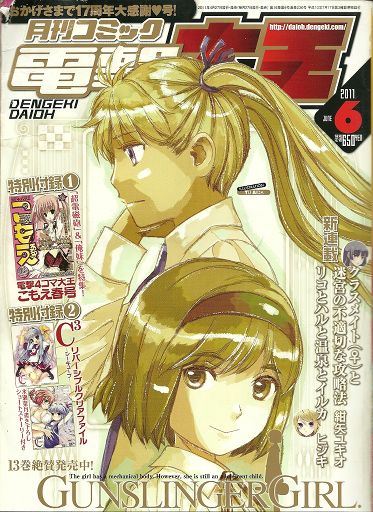
Triela and Henrietta, members of the Social
Welfare Agency since volume one.
Despite being mostly displeased with the second season of Gunslinger Girl during its initial broadcast four years ago, I bought the Il Teatrino Blu-ray discs anyway. I was much more impressed after this second viewing. Even in Blu-ray form, Il Teatrino suffers from the same problem the TV broadcast did, namely a tragically low animation budget. Curiously, though, I can't claim the production values in general are low, as the locales are still well-researched and the audio is much better than I expected. For example, a short scene showing bullets being loaded into a magazine includes sound effects that realistically duplicate the noise a handful of full metal jacket pistol rounds makes. I have no idea if the sound effect was recorded specifically for Il Teatrino or pulled from a bank of stock noises, but it's a good inclusion considering that some shows can't be bothered to differentiate between the sounds made by wooden baseball bats from those made by aluminum ones.
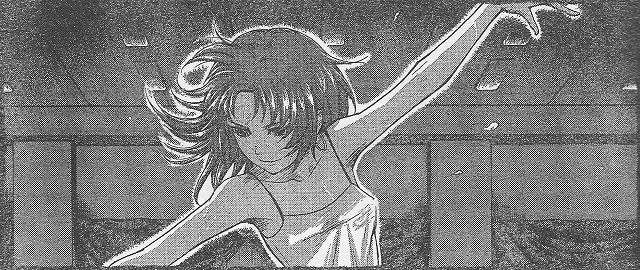
Petrushka didn't quite make it into Gunslinger Girl Il Teatrino, alas.
Possibly my greater appreciation of Il Teatrino also results from the 20/20 hindsight conferred by being up-to-date on the current manga run. As a point of reference, bear in mind the original season of Gunslinger Girl covered approximately one chapter per episode. Il Teatrino went a little further, extending the anime to about the first 30 chapters (ending before properly introducing Petrushka). A great deal more has occurred since then. The manga is now up to chapter 93 and is still ongoing. I could tell you the shit's hit the fan, but that may be an oversimplification of events. However, being caught up with the manga and having the benefit of knowing where the story is going and understanding more of the characters' backgrounds does make Il Teatrino better than watching it in a vacuum.
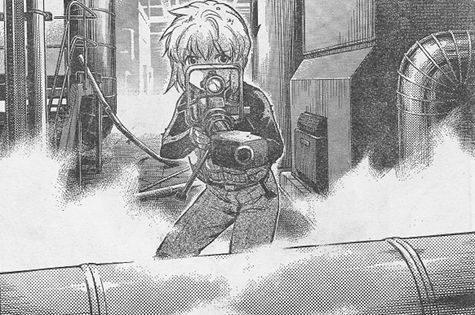
Rico is a lot better now than in Gunslinger Girl season one.
Additionally, I find the changes to the animation styles and character designs more faithful to the manga, at least in spirit, although I do find Henrietta's glassy-eyed vacant stare a little unsettling. Il Teatrino Rico's new-found personality is a more accurate reflection of her manga personality as the girl who subconsciously marvels at the freedom her cyborg body affords her, leaving her unusually cheerful despite her otherwise poor treatment.
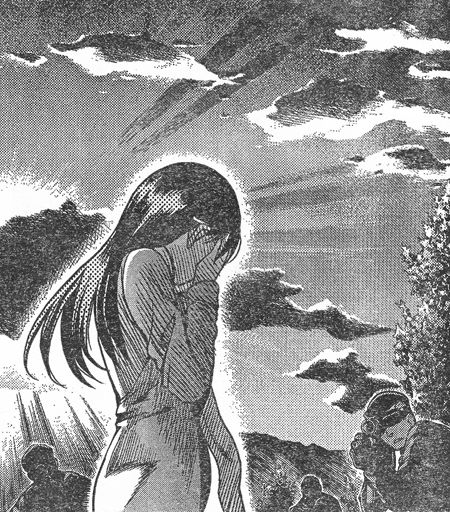
Claes is still the Gunslinger Best Girl.
Oh. I was going to recommend the Gunslinger Girl manga. Volumes one through eight are currently available, and volumes nine and 10 will be released as the fourth omnibus on March 13th. Hopefully Seven Seas will continue to release additional volumes regularly. (When ADV had the English-language rights to the Gunslinger Girl manga, there was a considerable lag between the releases of volumes three and four.) Never known for exactly pulling its punches, the Gunslinger Girl manga has currently reached a rather dark place. The short natural life spans of the cyborgs and the debilitating effects that occur prior to their death have been fixtures of the manga since the first volume and remain recurring themes throughout the story. By the 90s, the degradation has touched all the surviving girls from the manga's original crew. It's a good read, but don't get too attached. [P.S. Spoilers, I guess.]
Posted in BEST GIRL, Gunslinger Girl, Manga, RECOMMENDATIONS | Tags: Girls With Guns, Moe Blobs, Spoilers | Permanent Link
|
|






